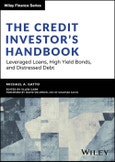The leveraged credit market is currently valued at over $4 trillion and is one of the fastest-growing asset classes, fueling demand for well-trained credit analysts.
The Credit Investor's Handbook: Leveraged Loans, High Yield Bonds, and Distressed Debt is the definitive guide for young investment professionals embarking on a career investing in the leveraged credit markets - whether public, private, performing, or distressed. Experienced professionals will also immensely benefit from this guide as they refine their investment skills.
Michael Gatto has twenty-five years of investing experience in the debt markets at Silver Point Capital (a $20 billion credit-focused fund) and Goldman Sachs' Special Situations Group. Furthermore, he is an adjunct professor at Columbia Business School and Fordham University's Gabelli School of Business. Michael brings these experiences together in this comprehensive manual, teaching the skills to succeed in the dynamic and complex credit markets. Michael brings highly complex case studies to life using decades of his first-hand war stories and combines them with reflections from leading industry professionals, often infused with humor, to make the book accessible, readable, and fun.
Michael's seven-step credit analysis process will prepare you for a career in credit investing at the top buy-side and sell-side firms on Wall Street by teaching you the technical skills needed to invest in the debt markets. Whether you are analyzing a loan origination in the private debt market, a new issue of a broadly syndicated loan (BSL), a high-yield bond (HY), or a secondary trade, the comprehensive knowledge gained from this book will equip you to make well-founded investment recommendations. Additionally, an entire section devoted to distressed debt investing incorporates a practitioner's perspective on the nuances of bankruptcy and restructurings to develop strategies to profit from opportunities in this opaque market. In clear, straightforward terms accessible to the layperson, Michael explains strategies pursued by distressed companies such as J. Crew and Serta that have led to creditor-on-creditor violence, giving you an insider’s perspective on some of the least understood transactions in the distressed arena.
You will: - Gain In-Depth Knowledge: Understand the complexities of credit markets, from trading dynamics to historical credit cycles, allowing you to identify debt investment opportunities - and avoid pitfalls. - Master the Analytical Framework: Learn Michael's seven-step process for analyzing credit investments, including qualitative industry and business analysis, financial statement analysis, forecasting, corporate valuation, relative value analysis, and debt structuring. - Learn How to Write an Investment Recommendation: Review real-life credit memos to understand how analysts translate this framework into recommendations that drive investment decisions at the top credit funds. - Discover Key Concepts and Terminology: leveraged buyout financings (LBOs), trading levels (price, yields, and spreads), shorting, and credit default swaps. - Navigate Distressed Debt: Explore the strategies and nuances of distressed debt investing, including bankruptcy, subordination, creditor-on-creditor violence, and high-profile case studies from the past three decades of Chapter 11 restructurings.
This book caters to finance majors pursuing investing careers, credit analysts seeking to enhance their skills, and seasoned professionals aiming to expand their expertise. Professors, researchers, lawyers, and advisors servicing the credit industry will also find immense value in this comprehensive guide.
Table of Contents
Disclaimer xi
Foreword xiii
Acknowledgments xv
About the Author xxi
About the Editor xxiii
Preface: My Story xxv
Introduction: Structure of the Book xxxi
Part One Building Blocks of the Leveraged Credit Markets 1
Chapter 1 Description and History of the Leveraged Finance Markets 3
Chapter 2 Credit Cycles 13
Chapter 3 A Primer on Leveraged Credit Trading Terminology 29
Chapter 4 A Primer on Leveraged Buyouts (LBOs) 39
Part Two The Seven- Step Process of Evaluating a Debt Investment 49
Chapter 5 Step 1 of the Credit Analysis Process: Sources and Uses 51
Chapter 6 Step 2 of the Credit Analysis Process: Qualitative Analysis 57
Chapter 7 Step 3(a) of the Credit Analysis Process: Financial Statement Analysis - Profitability 75
Chapter 8 Step 3(b) of the Credit Analysis Process: Financial Statement Analysis - Cash Flow and Liquidity 103
Chapter 9 Step 3(c) of the Credit Analysis Process: Financial Statement Analysis - Capital Structure 121
Chapter 10 Step 4 of the Credit Analysis Process: Forecasting 147
Chapter 11 Step 5 of the Credit Analysis Process: Corporate Valuation 171
Chapter 12 Step 6 of the Credit Analysis Process: Structuring and Documentation 189
Chapter 13 Step 7 of the Credit Analysis Process: Preparing an Investment Recommendation and Credit Committee Memo 203
Part Three Distressed Debt Investing 265
Chapter 14 Introduction to Distressed Debt Investing 267
Chapter 15 Bankruptcy 101 271
Chapter 16 Bankruptcy Fights 283
Chapter 17 How Subordination Works in Bankruptcy 301
Chapter 18 Liability Management and Creditor- on- Creditor Violence 317
Chapter 19 Making Money in Distressed Situations 329
Closing Comment
Chapter 20 My Closing Comment 365
Appendix Appendix The Quinn Case Study 369
Index 375








